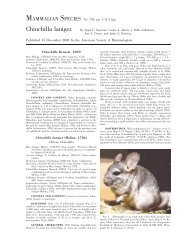Brugia Malayi - Clark Science Center - Smith College
Brugia Malayi - Clark Science Center - Smith College
Brugia Malayi - Clark Science Center - Smith College
Create successful ePaper yourself
Turn your PDF publications into a flip-book with our unique Google optimized e-Paper software.
A Longitudinal Study of Personality and Life Outcomes<br />
Xiaoye Xu<br />
How can we understand personality comprehensively and predict people’s future decisions? In my research on personality<br />
and life outcomes, I worked with Professor Peterson to Q-Sort age 26 interview data from people who are part of a longitudinal<br />
study. Professor Peterson has been collaborating with a colleague at Wilfred Laurier University, Professor Michael Pratt, who<br />
originally collected the data from subjects at ages 18, 23, 26, and 31. The Q-Sort is a measurement technique used by psychologists<br />
to quantify data on personality functioning and development. Our ultimate goal is to use age 26 Q-Sort data to predict age 31 life<br />
outcomes. I quantified 80 interviews with the Q-Sort. Each interview contained 20-30 pages of transcribed information about a<br />
subject’s work life, relationships, goals, regrets, and religious upbringing.<br />
For our study we used the California Adult Q-Sort developed by Jack Block (1961/2008) at UC Berkeley to standardize<br />
different raters’ perceptions of the same individual by providing raters with a common descriptive language to use. Examples of<br />
CAQ items include: “Is uncomfortable with uncertainty and complexity”, “Keeps people at a distance”, “Has warmth”, and “Is<br />
productive”. Over the summer I Q-sorted the interviews with Professor Peterson and other lab members. Multiple raters for<br />
each interview are necessary to establish levels of interrater reliability. At the beginning of the summer we established reliability<br />
by reading the same interview, conducting our Q-Sorts independently, and then discussing each case extensively. Our discussions<br />
broadened my horizons about how people live life, and enlightened me in ways that I hope will lead me to be more open and<br />
creative.<br />
At the end of this summer’s research, our lab had finished Q-sorting all 104 subjects at least once. We have reliable CAQ<br />
data for 68 subjects (65% of the sample). The remaining 36 subjects still need a third or fourth rater for reliability purposes.<br />
During the coming academic year we will complete the remaining Q-Sorts, enter the composite data into SPSS, and generate<br />
reliability, descriptive, and inferential statistics. Regarding the inferential statistics, we will examine how personality as assessed by<br />
the CAQ at age 26 predicts levels of generativity (i.e., desire to invest in society and care for others) and authoritarianism (i.e.,<br />
cognitive rigidity and aggressiveness) at age 31.<br />
Through the SURF I was given the opportunity to practice basic principles of personality and developmental research that<br />
I learned about in my Research Methods class. In addition, as an international student from China, reading records of interviews<br />
from North American citizens provided me with a useful resource to understand western culture, which is important to my<br />
future goals to compare Asian and western cultures. For example, from the interviews, I found out a lot about North American<br />
parenting practices and I could not help but compare this to Chinese parenting. I am developing plans now to write an honors<br />
thesis with Professor Peterson about Chinese parenting practices and will collect a pilot study in my junior year. (Supported by the<br />
Frances Baker Holmes Fund)<br />
Advisor: Bill Peterson<br />
References:<br />
Block, J. (1961/2008). The Q-Sort Method in Character Appraisal. Washington, DC: American Psychological Association.<br />
2012<br />
169

















